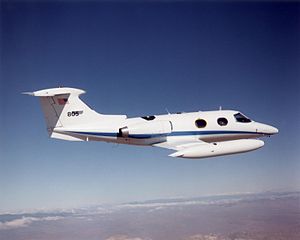Learjet 24
| Learjet 24 | |
|---|---|

| |
| NASA Learjet 24 | |
| Role | Business jet |
| Manufacturer | Learjet |
| First flight | January 24, 1966 |
| Introduction | November 9, 1966 |
| Status | Active |
| Primary users | Private Military NASA |
| Produced | 1966-1977 |
| Number built | 259 |
The Learjet 24 is an American six-to-eight-seat (two crew and four to six passengers) twin-engine, high-speed business jet, which was manufactured by Learjet as the successor to the Learjet 23.
History

The Learjet 24 was designed as an improved version of the Learjet 23, which was limited to 12,500 pounds (5,700 kg) gross weight. Engineers designed the model 24 to accept up to the full 13,500 pounds (6,100 kg) gross weight permitted by FAR-25 standards.
Other improvements introduced in the Learjet 24 included:
- increased cabin pressurization, to allow a higher operating altitude
- the addition of one extra window on each side of the cabin
- more powerful engines
- a new windshield
- auxiliary fuel in wing tip tanks
- a fire-extinguishing system for the engines
With these changes, the LJ24 became the first business jet to be certified under FAR-25.[1]
The first flight of a Learjet 24 took place on January 24, 1966. From May 23 to 26, 1966, a Learjet 24 flew around the world in 50 hours and 20 minutes flying time as a demonstration of its capabilities.[1] Different variants were the 24A, B, C, D, E and F, with changes of takeoff weight, in-fuselage fuel tank, range, cabin and engines.
Altogether 259 Model 24s were built, and in 2001, there were still 210 Learjet 24s in use. Thirty-nine LJ24s have been lost through accidents.
Noise compliance
In 2013, the FAA modified 14 CFR part 91 rules to prohibit the operation of jets weighing 75,000 pounds or less that are not stage 3 noise compliant after December 31, 2015. The Learjet 24 is listed explicitly in Federal Register 78 FR 39576. Any Learjet 24s that have not been modified by installing Stage 3 noise compliant engines or have not had "hushkits" installed for non-compliant engines will not be permitted to fly in the contiguous 48 states after December 31, 2015. 14 CFR §91.883 Special flight authorizations for jet airplanes weighing 75,000 pounds or less - lists special flight authorizations that may be granted for operation after December 31, 2015.
Variants
Learjet 24A
Standard version. Converted from existing Learjet 23. Takeoff weight 13,499 pounds (6,123 kg). FAA certified on November 9, 1966. 81 aircraft built.
Learjet 24B
Improved variant, powered by two 2,950 lbf (13.1 kN) thrust General Electric CJ610-6 turbojet engines, and 13,499 pounds (6,123 kg) maximum take-off weight. FAA certified December 17, 1968. 49 aircraft built.
Learjet 24C
A light-weight version of the 24B, fuselage tank not fitted which would have caused a reduction in range. The Learjet 24C project was abandoned in December 1970. Take-off weight 5,675 kilograms (12,511 lb). None built.
Learjet 24D
Similar to Learjet 24C, however by changing surface tanks range and takeoff weight were increased to 6,129 kilograms (13,512 lb). Round cabin windows replaced by angular. FAA certified July 17, 1970. Replaced the 24B in production.[1] A reduced gross weight (restricted to 12,500 pounds (5,700 kg) version was also available (the 24D/A). 99 built.
Learjet 24D/A
Light-weight version with a restricted take-off weight of 5669-kg (12,500-lb),
Learjet 24E and 24F
Two new versions were announced in 1976 the 24E and 24F, they introduced a new cambered wing and aerodynamic improvements to reduce stall and approach speed (Century III wing). The 24E did not have a fuselage fuel tank for higher payload but shorter range. Some 24E models had the fuselage tank installed later to restore range. Powered by two 2,950 lbf (13.1 kN) thrust General Electric CJ610-8A turbojet engines. On April 15, 1977, the FAA approved extended ceiling to 51,000 feet (16,000 m), the highest level then achieved in civilian aviation.[1] 29 aircraft built.
Survivors

- Learjet 24A (N1965L) s/n 012 -- Clay Lacy, Van Nuys, CA
- Learjet 24 (N241JA) s/n 131 -- Wings Over the Rockies Air and Space Museum, Denver, CO
- Learjet 24 (N100VQ)s/n 140 -- National Aviation Academy, Clearwater, Florida
- Learjet 24 (N995TD) s/n 149 -- Pulaski Technical College, Little Rock, Arkansas
- Learjet 24 (N723JW) s/n 24-142 -- Charter Airlines Inc., Hood River, OR
- Learjet 24 (N3137) s/n 123 EXPERIMENTAL --AVSTAR INC, Seattle, WA
- Learjet 24 (N45ED) s/n 104 --Aisling Developments LLC, Calhoun, GA
- Learjet 24 (N2DD) s/n 24E-335 --N2DD, Inc., Newark, DE
- Learjet 24 (XA-LNK) s/n 24-174 -- FLYERSTEAM, Guadalajara, MEX
- Learjet 24 (ex N991TD) s/n 124 --Universiti Tun Hussein Onn Malaysia, Johor, Malaysia
Operators
- FLYERSTEAM - Air Ambulance and Air Show performer
Former Operators
- Pacific Southwest Airlines - PSA only owned one Learjet 24 (Only used for training).
Specifications (Learjet 24F)
Data from Jane's All The World's Aircraft 1976–77[2]
General characteristics
- Crew: Two (pilot & co-pilot)
- Capacity: 6 passengers
- Airfoil: NACA 64A109
Performance
See also
Related development
Aircraft of comparable role, configuration, and era
Related lists
References
- Notes
- Bibliography
- Taylor, John W. R. Jane's All The World's Aircraft 1976–77. London:Jane's Yearbooks, 1976. ISBN 0-354-00538-3.
